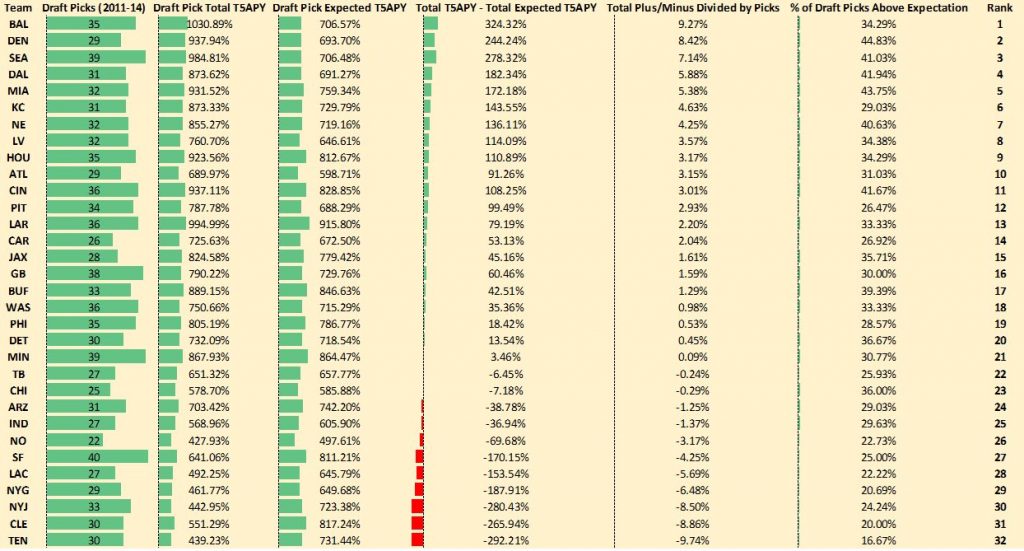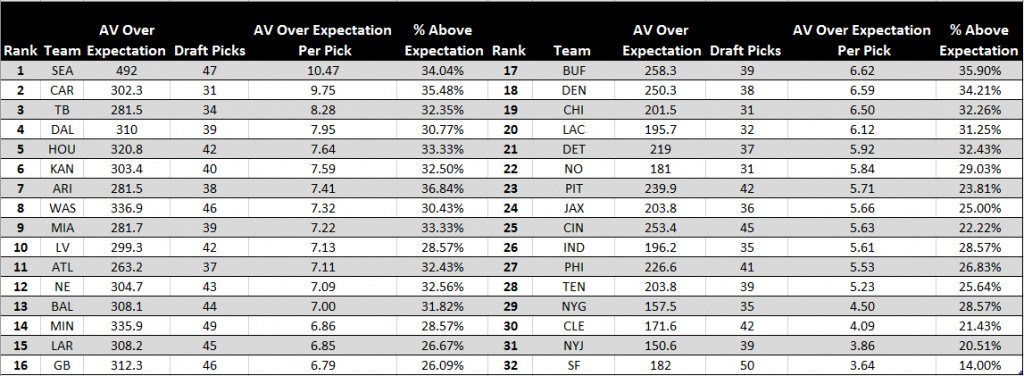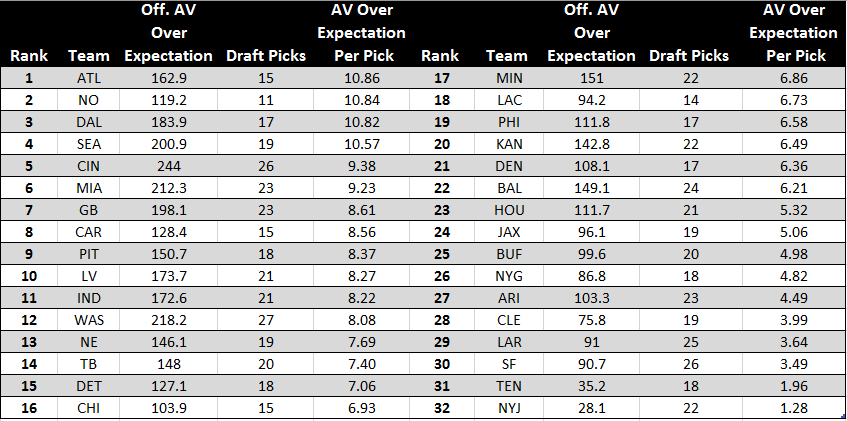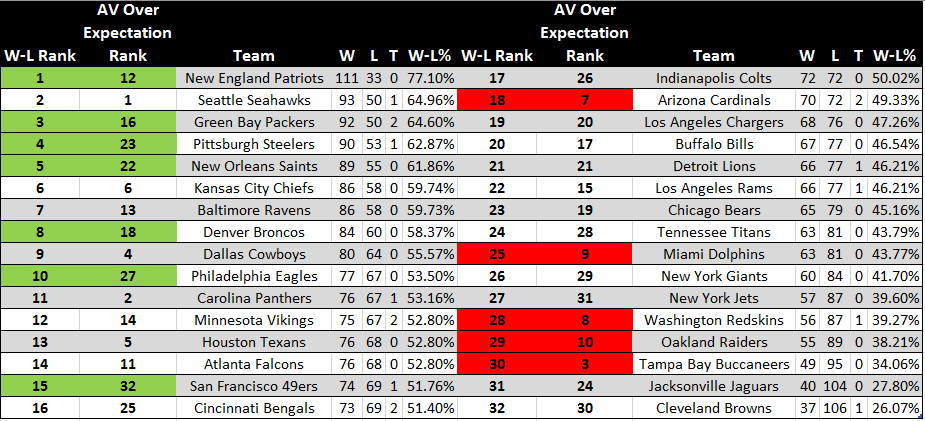Follow me on Twitter @BradOTC
I recently posted a breakdown of each team’s Draft success from 2011-2014 based on the Fitzgerald-Spielberger/Top 5 APY metric (concept explained here with a table of Draft pick values). I wanted to expand on the research with an investigation of Pro Football Reference Approximate Value. First, below is the Top 5 APY table:

2011-2014 Top 5 APY Over Expected
The above table examines every Draft pick from 2011-2014 for each team. The “Draft Pick Total T5APY” column lists the Total Top 5 APY or “T5APY” of every pick. Here is an example of how to calculate an individual player’s T5APY: “The Top 5 QB contracts based on APY (average per year) are $35 million, $34 million, $33.5 million, $33.5 million, and $32 million. The average of these 5 APY’s is $33.6 million. An APY of $16.8 million would thus be 50% of T5APY.”
We converted each post-rookie contract in each off-season into a percent of the T5APY average at the respective position. Next, we developed an expected T5APY for each Draft slot. For example, a No. 3 overall pick has an expected T5APY of around 80%. In other words, a No. 3 overall pick can be expected to sign a post-rookie contract worth 80% of the average of the Top 5 APY’s at their position. The “Draft Pick Expected T5APY” column is therefore the sum of all expected T5APY’s based on Draft slot.
Next, the “Total T5APY – Total Expected T5APY” is the actual results of each player’s post-rookie contract compared to their expectation based on their Draft slot. For example, if a No. 3 overall pick signed a post-rookie contract for 60% of T5APY, they would register as -20%.
The next column, “Total Plus/Minus Divided by Picks,” is what the table is ranked by. This divides the “Total T5APY – Total Expected T5APY” by the number of Draft picks. As you can see, the Baltimore Ravens were the best drafting team from 2011-2014 on a per pick basis. With their 35 draft picks over the four years, they beat Draft slot expectations by an average of 9.27%. While impressive, this also demonstrates that even the best drafting team over a multi-year stretch couldn’t beat Draft slot expectations by 10% on average.
It is also interesting to note, as you can see in the final column, “% of Draft Picks Above Expectation,” that the Ravens were not No. 1. That honor belongs to the Miami Dolphins, whose Draft picks signed a post-rookie contract that exceeded Draft slot expectations 43.75% of the time. More simply, 14 of the Dolphins’ 32 Draft picks over the four-year stretch signed larger post-rookie contracts than expected… and this was tops in the NFL. Again, the Draft is very hard.
I wanted to take this same principle and apply it using Chase Stuart’s Draft Pick value chart that uses Pro Football Reference Approximate Value (explained here). We can now add the 2015 Draft class as they have completed five seasons (whereas not all 2015 Draft picks have signed post-rookie contracts… No. 1 overall pick Jameis Winston being one such example).
Chase Stuart also developed a five-year AV expectation for each Draft pick, so I compared the actual AV output in every player’s first five seasons to their Draft slot expectation and ran the same analysis. Note: I did not only count the AV that a player contributed to his drafting team. I wanted to gauge a team’s ability to scout talent, not necessarily develop it. Furthermore, certain teams will have positions filled by veterans and no potential for a Draft pick to break into the lineup. This doesn’t mean the player is bad or the team is bad at scouting talent, it could just mean they were too stacked at that player’s position for him to see the field. However, there are many instances of these teams trading away such a player who gets an opportunity to log significant snaps elsewhere and they recoup solid Draft capital in return, arguably adding value for themselves via this player just in an indirect way.
Finally, on the opposite end of the spectrum, AV is an imperfect “WAR” metric because it is so heavily based on merely seeing the field, and a player can log a lot of bad snaps and still rack up AV. In the same way a team didn’t necessarily fail when a Draft pick doesn’t accumulate AV under their rookie contract, they didn’t necessarily succeed when a Draft pick is forced to play a lot and accumulates AV because the roster is weak at a certain position. For example, the aforementioned Jameis Winston accumulated an AV of 59 over his first five seasons, good for 14.4 AV Over Expectation. Nevertheless, he is still without a post-rookie contract as of today. This is a big reason why the Fitzgerald-Spielberger metric was developed, because we believe the open market does the best job of truly evaluating players (in essence, we’re following the money).
While AV is imperfect for these reasons, with five full Draft’s worth of data, the anomalies tend to cancel out and a clear correlation between Draft AV and Team Success emerges. First, here is the overall breakdown of Draft AV Over Expectation:

Total AV Over Expectation 2011-2015
To provide a frame of reference, Calais Campbell had a 2019 AV of 10, which is a good year worth Pro Bowl consideration. A rather average season for a 16 game starter would be around a 5 AV. Chase Stuart found that a replacement level AV for a season was around 2. Individual seasons are not great ways to compare players (the creator of AV says so himself), but 5 seasons for each player vastly improves the overall outlook.
It is important to note that Chase Stuart’s Draft Pick Values are based on Value Above Replacement Player. So, he subtracted 2 AV (the single-season AV he determined was replacement level) from every player season to develop his expected value table. Therefore, over 5 seasons you would subtract 10 AV from every player. For the table column “AV Over Expectation,” I chose to not remove the 10 AV for each player just so it is not a mess of negative decimal values. The team rankings would still be the same, but it would show the Seahawks were the only team in the NFL from 2011-2015 that drafted above replacement level on average. Their Total AV Over Expectation would be 22, across 47 Draft picks, good for +.47 AV Over Expectation Per Pick. The Panthers at No. 2 would have a Total AV Over Expectation of -7.7, across 31 Draft picks, good for -.25 AV Over Expectation Per Pick. Every team is going to select players that never see the field and register a five-season AV of 0, it’s simply unavoidable. In this 2011-2015 sample, about 11.75% or 1 in every 8.5 Draft picks registered a five-season AV of 0. (Shoutout Cardinals QB Ryan Lindley (-4) and Lions K Nate Freese (-1) for the only negative five-season AV’s in the sample).
Over this 5-year sample, the best AV Over Expectation was Russell Wilson, whose total AV of 84 exceeded his No. 75 Draft slot expectation (17.1) by 66.9. The worst was 2013 No. 3 overall pick Dion Jordan, whose total AV of 4 fell short of his No. 3 Draft slot expectation (37.6) by 33.6.
It should come as no surprise that the Seahawks had the No. 1 (Wilson), No. 2 (Richard Sherman), and No. 5 (Bobby Wagner) Draft picks based on AV Over Expectation. The Seahawks also had their Draft picks exceed 5-year expectations 34.04% of the time. So, over 1/3 of Seattle’s Draft picks from 2011-2015 produced more AV over their first five seasons than was expected based on where they were selected. They not only had 3 mega hits, but they were pretty consistent as well.
Next, I split the teams’ Draft picks into Offense and Defense. First, here is Offense:

Offense AV Over Expectation 2011-2015
Next, Defense:

Defense AV Over Expectation 2011-2015
Finally, while I fully recognize Draft pick production is just one (albeit large) part of the equation when it comes to competing in the NFL, I wanted to cross-reference these rankings with team W-L rankings:

AV Over Expectation vs. W/L Record
Because 2015 Draft picks had their first five seasons span from 2015-2019, I compiled the W-L records from 2011-2019. First caveat, this obviously ignores Draft classes from 2016-2019, which are pretty important (Nick Bosa and Deebo Samuel for example Oh, or Patrick Mahomes…). Secondly, it ignores the teams’ rosters entering the sample in 2011. Nevertheless, the correlation is pretty clear. It may not look it at first when you look at the teams highlighted in Green or Red. These are all the teams whose ranking in Draft AV Over Expectation Per Pick differed from their W-L Rank by 10 or more. Check out this very scientific reasoning that explains almost all of the Green team variance:
Patriots – Tom Brady & Bill Belichick
Green Bay Packers – Aaron Rodgers & Mike McCarthy
Pittsburgh Steelers – Ben Roethlisberger & Mike Tomlin
New Orleans Saints – Drew Brees & Sean Payton
Denver Broncos – Peyton Manning
Philadelphia Eagles – Andy Reid, Michael Vick, Doug Pederson, Carson Wentz.
Lastly, a perfect example of what can happen with some awful Draft classes: San Francisco 49ers – Jim Harbaugh and Colin Kaepernick. BUT, in the four seasons from 2011-2014 they had 44 wins. In the four seasons from 2015-2018, they had 17. Clearly, those Draft classes caught up to them. Their 2016-2019 Draft classes featured DeForest Buckner, George Kittle, Mike McGlinchey, Fred Warner, Nick Bosa and Deebo Samuel. They also added arguably the best offensive mind in football in Kyle Shanahan at HC.
The Red teams are essentially the exact opposite. These teams featured Quarterback carousels that brought everything else down, and a good amount of coaching turmoil. The Cardinals with a healthy Carson Palmer and Bruce Arians at HC from 2013-2015 went 29-9 with an NFC Championship appearance. Everything besides that was… not pretty.
At the end of the day, this game is, and always will be, about Draft picks. Just 10 days away from Christmas morning, er, I mean Day One of the NFL Draft on April 23.
Keep an eye out for another article coming soon exploring Draft Pick trades from 2011-2019.
Follow me on Twitter @BradOTC